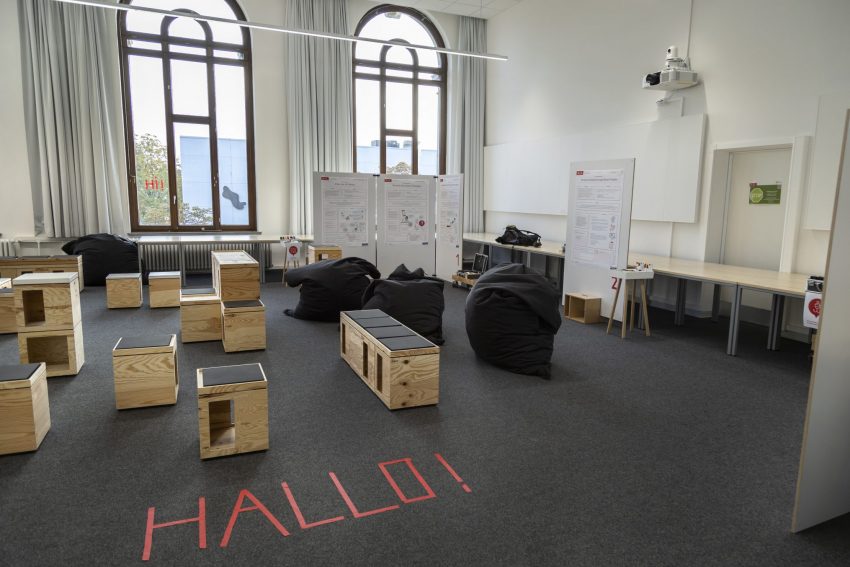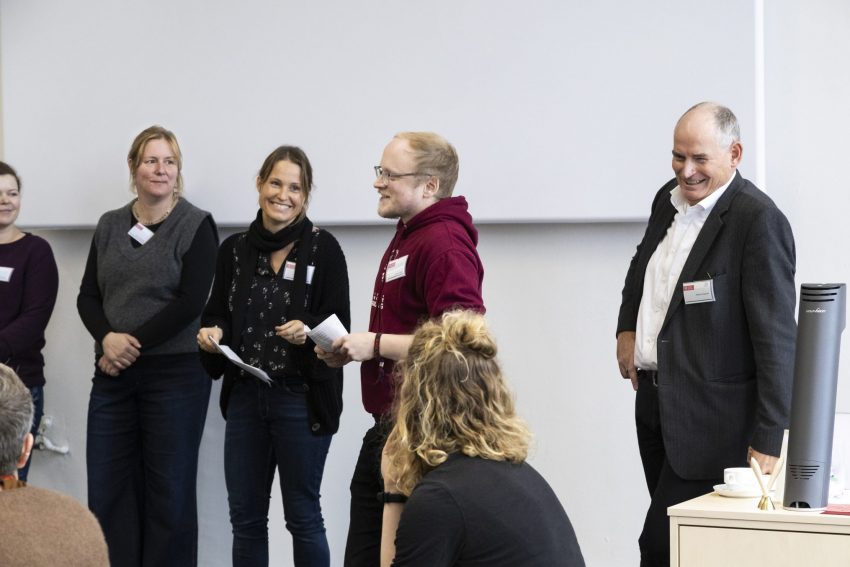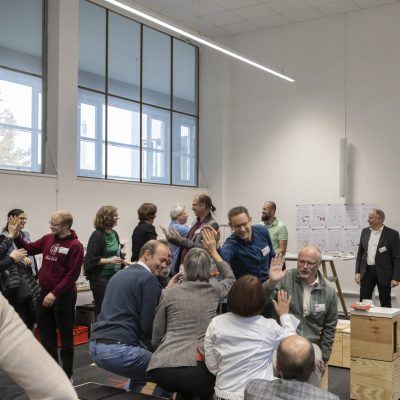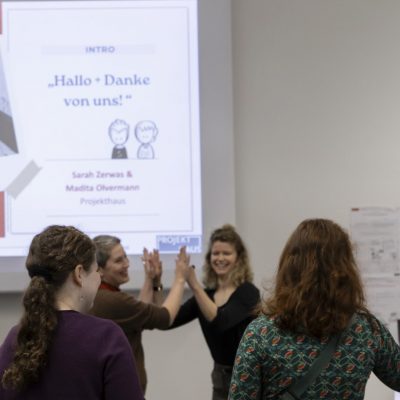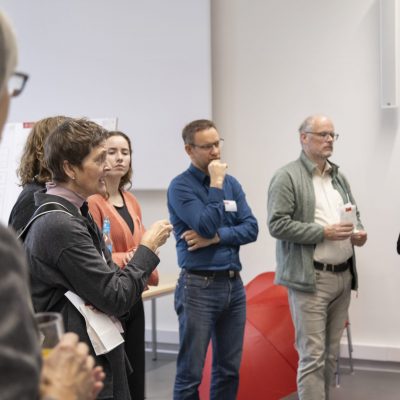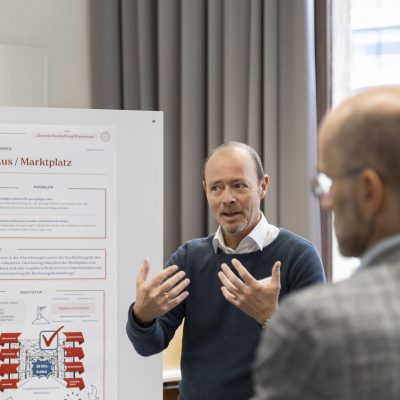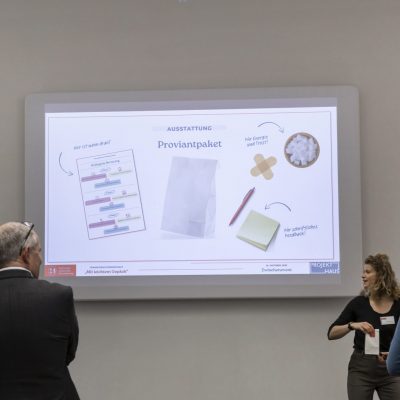“Travelling light” 22 prototypes enter the testing phase
Following the project launch and the mood survey during the summer break, the TU Braunschweig transformation project “Travelling light”, led by Dietmar Smyrek, TU Vice-President for Human Resources, Finance and University Construction, is entering the next stage of a special expedition: 22 prototypes to simplify everyday university processes.
Project coordinators Madita Olvermann and Sarah Zerwas report on the start of this stage:
Dialogue, courage and creative enthusiasm
Every expedition has its stopover: a moment when the team pauses to check the route, recharge their batteries for the next few kilometres, and discover amazing things in their luggage. That’s exactly how the interim event of “Mit leichtem Gepäck” felt: Last Friday, the nine teams gathered in the open space, ready to present their prototypes, encourage each other, and boldly embark on the final seven weeks of the project phase, which involves testing the prototype ideas. Dietmar Smyrek, the client and project initiator, is enthusiastic about the teams: “The format chosen by the project house has triggered an unimaginable desire for innovation and a wealth of great ideas among the expedition participants. The teams were wonderfully productive and created great prototypes. Now it’s time for testing, and I hope that many of the prototypes will be realised.”
Amid lively discussions and fast-paced pitch rounds that were both entertaining and engaging, the approximately 50 project team members impressively demonstrated the great potential for innovation in administrative processes at the interim event.
Upon arrival, there was a mixture of curiosity and scepticism. “I was a little sceptical at first, but now I have a good gut feeling,” admitted one participant, offering an honest reflection on a project that requires courage and a willingness to embrace change. Overall, the day offered a “refreshingly low threshold” and a “great space for ideas – which everyone is open to for now” said Dr Maurice Scheer, a member of the staff council and an employee at the Gauss IT Centre. Petra Eimbeck, Head of Department 22, agrees, saying, “Overall, it’s a great platform for trying out new working formats and getting support to pursue these new paths.”
During the open exchange on the team islands after the short pitch rounds, the teams demonstrated their creativity and curiosity. My colleague Sarah Zerwas and I once again made it clear to today’s participants how much fun we had supporting the teams in workshops, work meetings, feasibility walks and poster production in our role as process facilitators over the past few months. Despite varying workloads and levels of frustration, we are grateful that everyone put so much energy and commitment into the project. We were thrilled by the enthusiasm for design. This was celebrated with a high five at the start of the event.
- Die Begeisterung und Gestaltungsfreude war spürbar… Bildnachweis: TU Braunschweig
- …und
Thanks to this commitment and the palpable enthusiasm for design, each team island with its prototype posters became a real source of energy at the event.
- Bildnachweis: TU Braunschweig
- Bildnachweis: TU Braunschweig
- Bildnachweis: TU Braunschweig
The various pitches provided new impetus, but they also demanded clear answers. How can the prototypes be tested in a meaningful and resource-efficient way? Which solutions are easy to implement? We told the teams that failure of individual ideas is expressly permitted at this stage and provided them with small provisions packages including Dextro Energy to boost their energy for the day.
“I expect and hope that solutions will be created that feel easy in retrospect and can also be implemented – and don’t just disappear into a drawer,” said another participant, aptly summarising her expectations.
Making innovation visible: 22 prototypes at the heart of the event
The event focused on a total of 22 prototype ideas from the nine teams, which provided a breath of fresh air and sparked curious questions. The teams presented a variety of ideas, ranging from small, quickly implementable solutions to larger approaches designed to initiate structural changes in processes to simplify them.
The “Where can I work?” campaign from the “New Work” team, for example, aims to make work and learning locations on campus easier to find using a campus map. The “Tech Tinder” chat, on the other hand, is designed to create a simple space for addressing digital issues: three key questions help users to articulate their concerns, and colleagues can join in or share their knowledge. Another prototype, from the “Support instead of control” team, focuses on the principle of “thinking outside the box” and opens up new opportunities for exchange and collaboration through work shadowing. Particular interest was attracted by the digital warehouse, a smart marketplace for resources that simplifies purchasing, reduces the accounting workload and supports sustainable procurement, developed by the “Central Procurement/Warehouse” team. It was clear during the event that there is huge potential for real added value. “If the warehouse comes to fruition, even to a limited extent, the light luggage will have been well worth it,” said Prof. Robert Hänsch, Head of the Department of Stress Physiology and Bioimaging at the Institute of Plant Biology.
Together with the other 18 prototypes, this clearly demonstrates how diverse and imaginative the journey to better working practices is proving to be.
Looking ahead
As with any great journey, once one milestone has been reached, the next stage begins. The agenda for the interim event provided a framework for exchange and re-evaluation of what has been achieved, as well as offering an optimistic outlook on the future. “I am thrilled by the momentum that has emerged from the first phase and am excited to see the results of the next stage of the project,” said Dr Konrad Schäfer, Managing Director of Faculty 6. This statement aptly sums up the spirit of the expedition.
The journey continues: “What needs to happen now to ensure the project’s continued success beyond December?” This question was at the forefront of the discussions at the end of the event and will guide the coming weeks, during which the prototypes will undergo practical testing to reveal their greatest potential.
Curious to find out more? Over the next few weeks, we will be presenting one or two teams and their prototype solutions in “Die Woche” (The Week). You can also find all the latest news and background information on the “Mit Leichtem Gepäck” (Travelling Light) project on the project homepage.
Text: Dr Madita Olvermann

